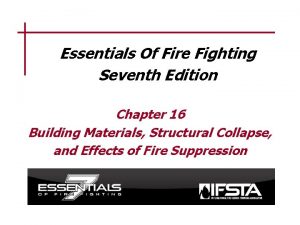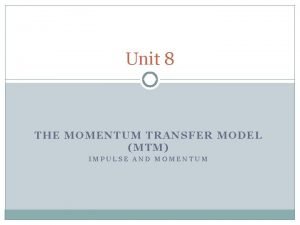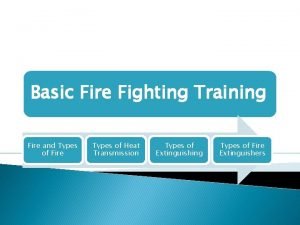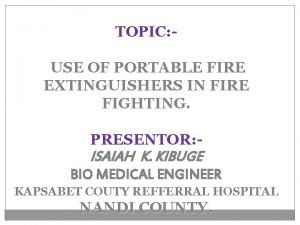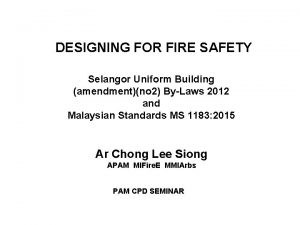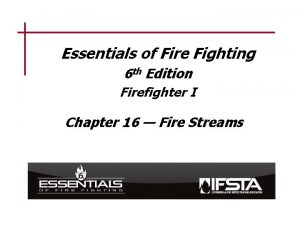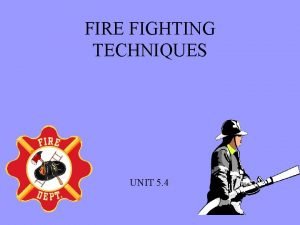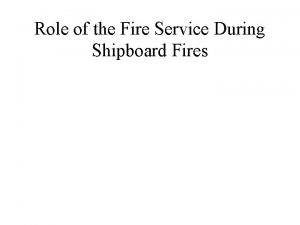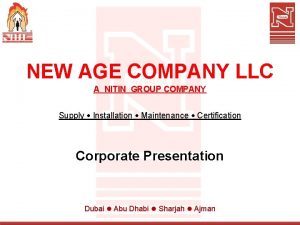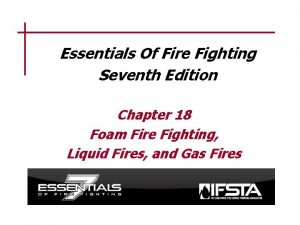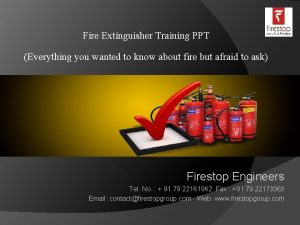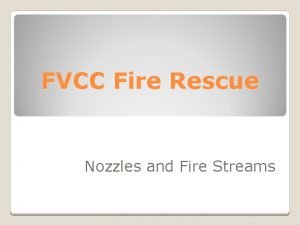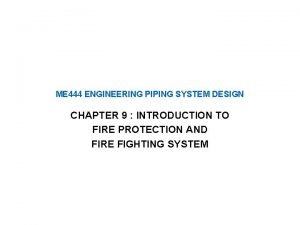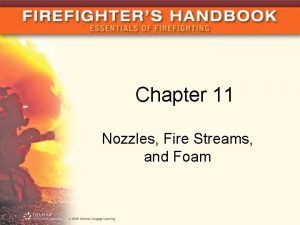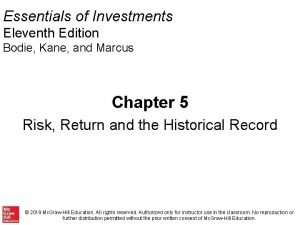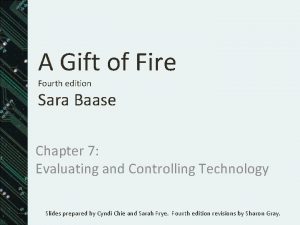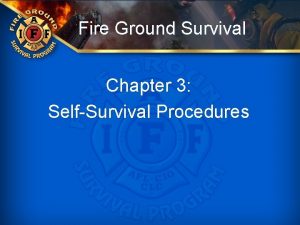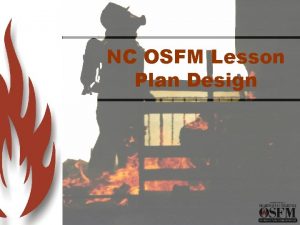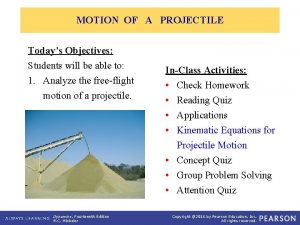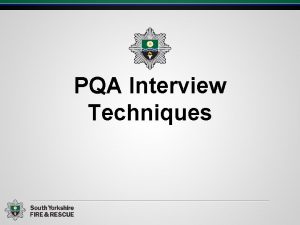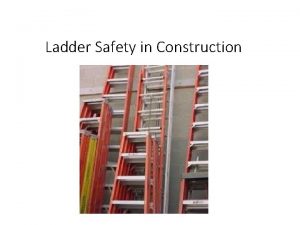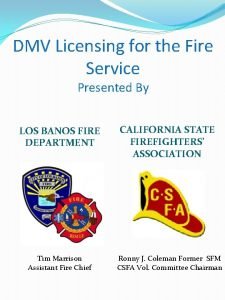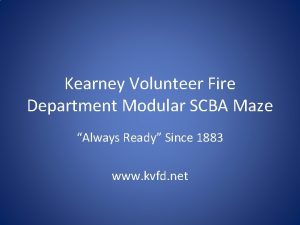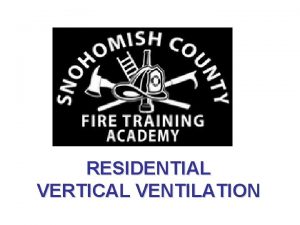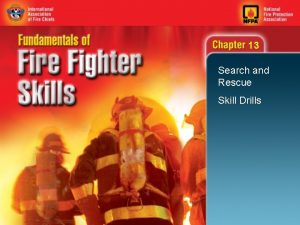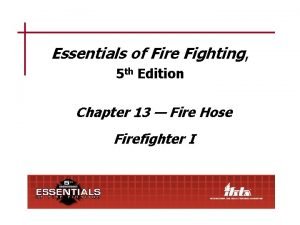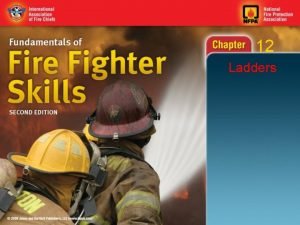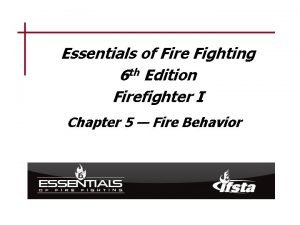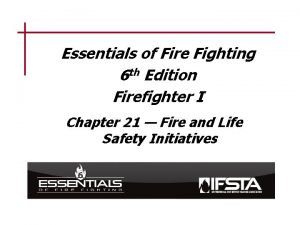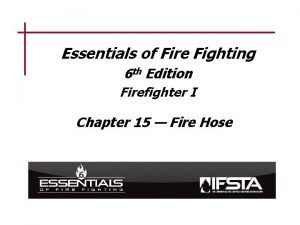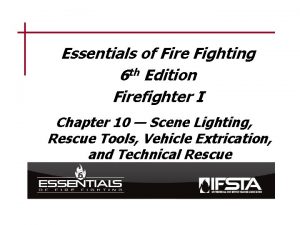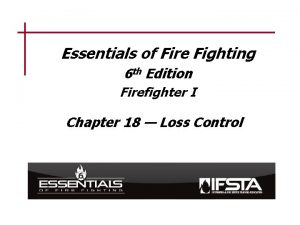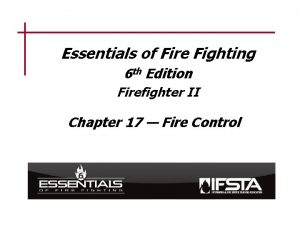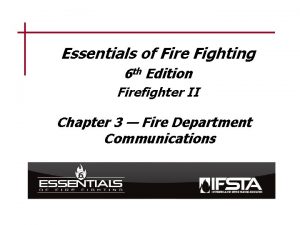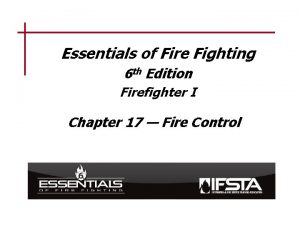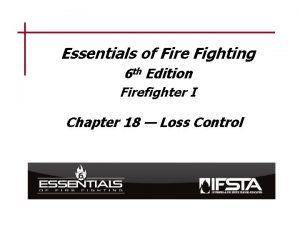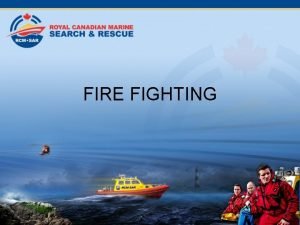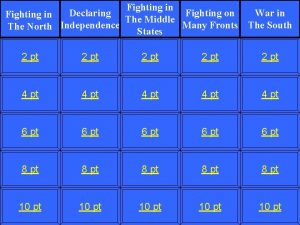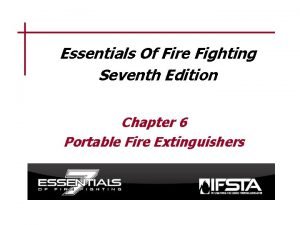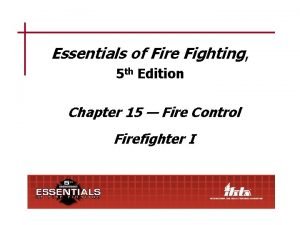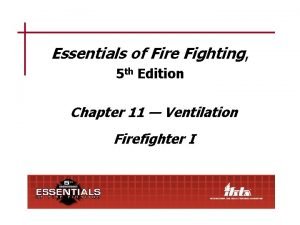Essentials of Fire Fighting 6 th Edition Firefighter



















































- Slides: 51


Essentials of Fire Fighting 6 th Edition Firefighter I Chapter 13 — Tactical Ventilation

Learning Objective 1 Describe reasons for tactical 13– 3 ventilation.

Tactical ventilation is carefully planned to achieve the best results. Planned, systematic, coordinated removal Performed for Performed only when fire attack hoselines, teams 13– 4 • Heated air • Smoke • Gases • Other airborne contaminants • Life safety • Incident stabilization • Property conservation • In place • Ready to attack

The success of tactical ventilation depends on several factors. Careful planning Knowledge of building construction Systematic application of procedures Coordination with other activities 13– 5

Tactical ventilation is performed for several general reasons. Reduce interior heat levels Decrease rate of fire spread Reduce potential of extreme fire behavior Improve interior visibility Improve firefighter efficiency Improve victim survival Reduce smoke, property damage 13– 6

Tactical ventilation can be effective when correctly implemented. Properly implemented Improperly applied – Can impact • Life safety • Incident stabilization • Occupants • Property • Firefighters conservation • Physical structure 13– 7

Tactical ventilation can improve life safety, the highest incident priority. Increasing oxygen concentration Reducing concentration of toxic products Reducing temperature Increasing visibility Creating smoke-free paths of egress 13– 8

Incident stabilization can be accomplished through ventilation. Stages to control, extinguish fire Locate Confine 13– 9 Extinguish

Ventilation can influence property conservation. Can remove smoke, gases, heat and confine fire to specific area Salvage can begin outside of immediate fire area if enough personnel Ventilation can increase speed of fire extinguishment 13– 10

REVIEW QUESTION What are the reasons for tactical 13– 11 ventilation?

Learning Objective 2 Identify considerations that affect the decision to ventilate. 13– 12

Learning Objective 3 Explain the critical fire behavior present during tactical ventilation. 13– 13 indicators

Both occupants and firefighters are at risk during a structural fire. Occupants – Life hazards Firefighters – Expected hazards • Lower if awake • Several possibilities if asleep • Visual impairment • Lack of oxygen • Presence of toxic, flammable gases • Rapid fire development possible 13– 14

Changes in building construction present different risks during fires. Residential structure and lot size differences Layout, construction material changes Open plan commercial structures Energy conservation measures Use of plastics, synthetic materials 13– 15

Knowledge of the building can help make decisions concerning ventilation. 13– 16

Various building characteristics should be considered when ventilating. Occupancy classification Ceiling height Construction type Floor area, compartmentation Number of stories Number, size of exterior windows, doors, other wall openings (Cont. ) 13– 17

Various building characteristics should be considered when ventilating. Number, location of staircases, elevator shafts, dumbwaiters, ducts, roof openings External exposures Connection to adjoining structures Type, design of roof Type, location of fire protection systems Contents HVAC system 13– 18

Several fire behavior indicators also help with planning for ventilation. Courtesy of Bob Espositio Smoke Air flow (Cont. ) 13– 19

Several fire behavior indicators also help with planning for ventilation. Flame 13– 20 Courtesy of Mike Wieder Heat

CAUTION Do not rely solely on the presence or location of flames to assess an incident. 13– 21

REVIEW QUESTION How do smoke, air flow, heat, and flame impact fire behavior in a structure? 13– 22

First arriving units must determine size, location, and extent of the fire. Uncoordinated ventilation • Can spread fire or cut off escape Severity, extent of fire depends on several factors Primary consideration 13– 23 • Phase to which fire has progressed

The type of ventilation used will depend on several factors. Coordination with other operations Before orders are given IC determines if necessary Conditions upon arrival Must be appropriate for situation Must be capable of exhausting volume 13– 24

The location for ventilation must be selected based on several factors. Location of occupants Existing roof openings Desired air flow path Building construction Wind direction Extent of fire progress Condition of building, contents (Cont. ) 13– 25

The location for ventilation must be selected based on several factors. Potential structural collapse Effect on fire Effect on exposures Readiness of crew Ability to protect exposures Protecting means of egress, access 13– 26

Weather conditions will affect what happens inside a building as well. Building openings Other conditions 13– 27 Wind- most important

CAUTION A strong wind can overpower the natural convective effect of a fire and drive the smoke and hot gases back into the building. 13– 28

Exposures should be taken into account when planning ventilation. Internal • Affected by routing of smoke • Ventilation can create danger External • Affected by radiation, direct flame contact 13– 29

Staffing and resources are both requirements for ventilation. Resources needed • Forcible entry tools • Power saws • Fans or blowers • Smoke ejectors • Flexible ducts • Stacking and hanging devices • Other support systems • Electrical power cords • Generators 13– 30

REVIEW QUESTION What considerations will affect the decision to ventilate? 13– 31

Learning Objective 4 Define horizontal and vertical ventilation. 13– 32

Learning Objective 5 Explain the means for achieving vertical ventilation. 13– 33 horizontal and

There are two main types of tactical ventilation that can be performed. Heat, smoke, other parts of combustion channeled out through existing or created horizontal openings Horizontal Ventilation (Cont. ) 13– 34

There are two main types of tactical ventilation that can be performed. Ventilating at point above the fire; channeling contaminated atmosphere out the top Vertical Ventilation 13– 35

There are three means to accomplish ventilation used in the fire service. Natural Mechanical Hydraulic 13– 36

There are several indicators of the need for mechanical or hydraulic ventilation. Building or Location, size fire dictates determined other method Involved area too large for natural Layout not conducive to natural Fire below ground Natural slows, needs support 13– 37

REVIEW QUESTION What are the basic means used to accomplish ventilation? 13– 38

Learning Objective 6 Describe the types of horizontal 13– 39 ventilation.

Horizontal ventilation can be applied to several types of structures. Building where fire has not involved attic, cockloft Multistory building with fire below top floor, or top floor if attic uninvolved Building so weakened unsafe for vertical ventilation Building with daylight basement Building where vertical ventilation ineffective 13– 40

Natural horizontal ventilation works with existing conditions to take advantage of natural air flow. 13– 41

There are two types of mechanical horizontal ventilation. Negative-pressure ventilation (NPV) Positive-pressure ventilation (PPV) 13– 42

NPV uses smoke ejectors to expel and pull smoke from a structure. Know placement process • In windows openings • On leeward side • Properly seal • Flow of smoke, gases • Avoid opening windows, doors near ejector • Remove obstacles • Do not allow ejector to be obstructed Understand selection and use • Use intrinsically safe if needed • Turn off when carrying • Cautions before starting • Avoid air discharge from an 13– 43

PPV uses a fan to create slightly higher pressure inside a structure than is outside. 13– 44

WARNING! Improperly applied, PPV can change the interior conditions and injure personnel working inside the structure. 13– 45

PPV has both advantages and disadvantages. Advantages Disadvantages • • • Structure must be intact • May increase interior carbon monoxide levels if fan exhaust enters • May accelerate, spread hidden fires Set up Effectiveness Efficiency Limits currents Operate efficiently Cleaning, maintenance less Effective in all structure types Able to direct Can be pressurized 13– 46

Hydraulic ventilation is used when other types of forced ventilation are unavailable. 13– 47

REVIEW QUESTION What are the main types of ventilation? 13– 48 horizontal

You should know the precautions against upsetting horizontal ventilation. May pressurize building, intensify fire, cause fire spread May reduce or eliminate positive effects of air currents 13– 49

Mechanical ventilation has both advantages and disadvantages. Advantages Disadvantages • Enhances natural ventilation • Can cause fire to intensify, • Ensures more air flow control spread • Depends on power source • Speeds removal of contaminants • Requires special equipment, additional resources and • Reduces smoke damage personnel • Promotes good public relations • Benefits spaces with low oxygen levels 13– 50

REVIEW QUESTION How do the advantages and disadvantages of natural, mechanical, and hydraulic ventilation compare to one another? 13– 51
 Firefighter essentials 7th edition
Firefighter essentials 7th edition Momentum bar chart
Momentum bar chart Prefix fire
Prefix fire Mechanical ventilation firefighting
Mechanical ventilation firefighting Ship fire fighting equipment
Ship fire fighting equipment Method of fire fighting
Method of fire fighting Starving in fire fighting
Starving in fire fighting Uniform building by-law malaysia latest
Uniform building by-law malaysia latest Broken stream nozzle
Broken stream nozzle Fire fighting techniques
Fire fighting techniques Foampro fire fighting
Foampro fire fighting Shipboard fire fighting organization
Shipboard fire fighting organization Nitie fire alarm panel
Nitie fire alarm panel At a bulk transport incident, firefighters must:
At a bulk transport incident, firefighters must: Basic fire fighting training ppt
Basic fire fighting training ppt 3 types of fire streams
3 types of fire streams Sprinkler pipe sizing chart
Sprinkler pipe sizing chart Rain down foam application method
Rain down foam application method Business essentials 12th edition free
Business essentials 12th edition free Essentials of organizational behavior 14th edition
Essentials of organizational behavior 14th edition William stallings network security essentials 5th edition
William stallings network security essentials 5th edition Essentials of sociology 5th edition
Essentials of sociology 5th edition Cryptographic systems are generically classified by
Cryptographic systems are generically classified by Business essentials 12th edition
Business essentials 12th edition Business essentials 12th edition
Business essentials 12th edition Criminal justice wedding cake diagram
Criminal justice wedding cake diagram Essentials of investments 11th edition
Essentials of investments 11th edition Management information systems 13th edition
Management information systems 13th edition Chapter 1
Chapter 1 Using mis 10th edition
Using mis 10th edition Neo luddite criticisms of computer technology
Neo luddite criticisms of computer technology A gift of fire 4th edition
A gift of fire 4th edition Grab lives iaff
Grab lives iaff Nc osfm firefighter lesson plans
Nc osfm firefighter lesson plans Firefighter mayday acronyms
Firefighter mayday acronyms Firefighter hose
Firefighter hose Firefighter pqa
Firefighter pqa Firefighter
Firefighter Three legged step ladder
Three legged step ladder What is a firefighter endorsement dmv
What is a firefighter endorsement dmv Lafd interview questions
Lafd interview questions Firefighter maze plans
Firefighter maze plans Types of vertical ventilation cuts
Types of vertical ventilation cuts Mine rescue 13-5
Mine rescue 13-5 Twin donut roll
Twin donut roll Aims for first aid
Aims for first aid A ladder belt or a leg lock should be used when
A ladder belt or a leg lock should be used when Fire hose reel signage standards
Fire hose reel signage standards Ire fire fire rwi
Ire fire fire rwi Reichstag fire who was the fire starter
Reichstag fire who was the fire starter Race fire safety
Race fire safety Fire damper connection to fire alarm
Fire damper connection to fire alarm
